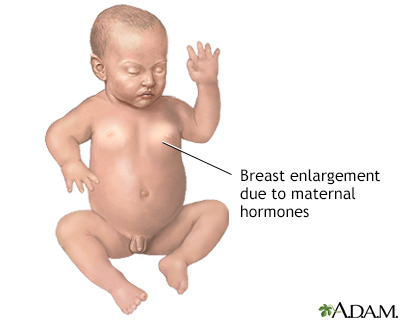
Newborn breast swelling; Physiologic leukorrhea
Hormonal effects in newborns occur because in the womb, babies are exposed to many chemicals (hormones) that are in the mother's bloodstream. After birth, the infants are no longer exposed to these hormones. This exposure may cause temporary conditions in a newborn.

Hormones from the mother (maternal hormones) are some of the chemicals that pass through the placenta into the baby's blood during pregnancy. These hormones can affect the baby.
For example, pregnant women produce high levels of the hormone estrogen. This causes breast enlargement in the mother. By the third day after birth, breast swelling may also be seen in newborn boys and girls. Such newborn breast swelling does not last, but it is a common concern among new parents.
The breast swelling should go away by the second week after birth as the hormones leave the newborn's body. DO NOT squeeze or massage the newborn's breasts because this can cause an infection under the skin (abscess).
Hormones from the mother may also cause some fluid to leak from the infant's nipples. This is called witch's milk. It is common and most often goes away within 2 weeks.
Newborn girls may also have temporary changes in the vaginal area.
These changes are common and should slowly go away over the first 2 months of life.
Katugampola H, Khairi RE, Dattani MT. Fetal and neonatal endocrinology. In: Robertson RP, ed. DeGoot's Endocrinology. 8th ed. Philadelphia, PA: Elsevier; 2023:chap 130.
Katugampola H, Gevers EF, Dattani MT. Endocrinology of fetal development. In: Melmed S, Auchus, RJ, Goldfine AB, Koenig RJ, Rosen CJ, eds. Williams Textbook of Endocrinology. 14th ed. Philadelphia, PA: Elsevier; 2020:chap 23.
Montano GT, Torres OA. Pediatric and adolescent gynecology. In: Zitelli, BJ, McIntire SC, Nowalk AJ, Garrison J, eds. Zitelli and Davis' Atlas of Pediatric Physical Diagnosis. 8th ed. Philadelphia, PA: Elsevier; 2023:chap 19.
BACK TO TOPReview Date: 1/24/2023
Reviewed By: Neil K. Kaneshiro, MD, MHA, Clinical Professor of Pediatrics, University of Washington School of Medicine, Seattle, WA. Also reviewed by David C. Dugdale, MD, Medical Director, Brenda Conaway, Editorial Director, and the A.D.A.M. Editorial team.

|
A.D.A.M., Inc. is accredited by URAC, also known as the American Accreditation HealthCare Commission (www.urac.org). URAC's accreditation program is an independent audit to verify that A.D.A.M. follows rigorous standards of quality and accountability. A.D.A.M. is among the first to achieve this important distinction for online health information and services. Learn more about A.D.A.M.'s editorial policy, editorial process and privacy policy. A.D.A.M. is also a founding member of Hi-Ethics and subscribes to the principles of the Health on the Net Foundation (www.hon.ch). |
The information provided herein should not be used during any medical emergency or for the diagnosis or treatment of any medical condition. A licensed medical professional should be consulted for diagnosis and treatment of any and all medical conditions. Call 911 for all medical emergencies. Links to other sites are provided for information only -- they do not constitute endorsements of those other sites. © 1997- A.D.A.M., Inc. Any duplication or distribution of the information contained herein is strictly prohibited.